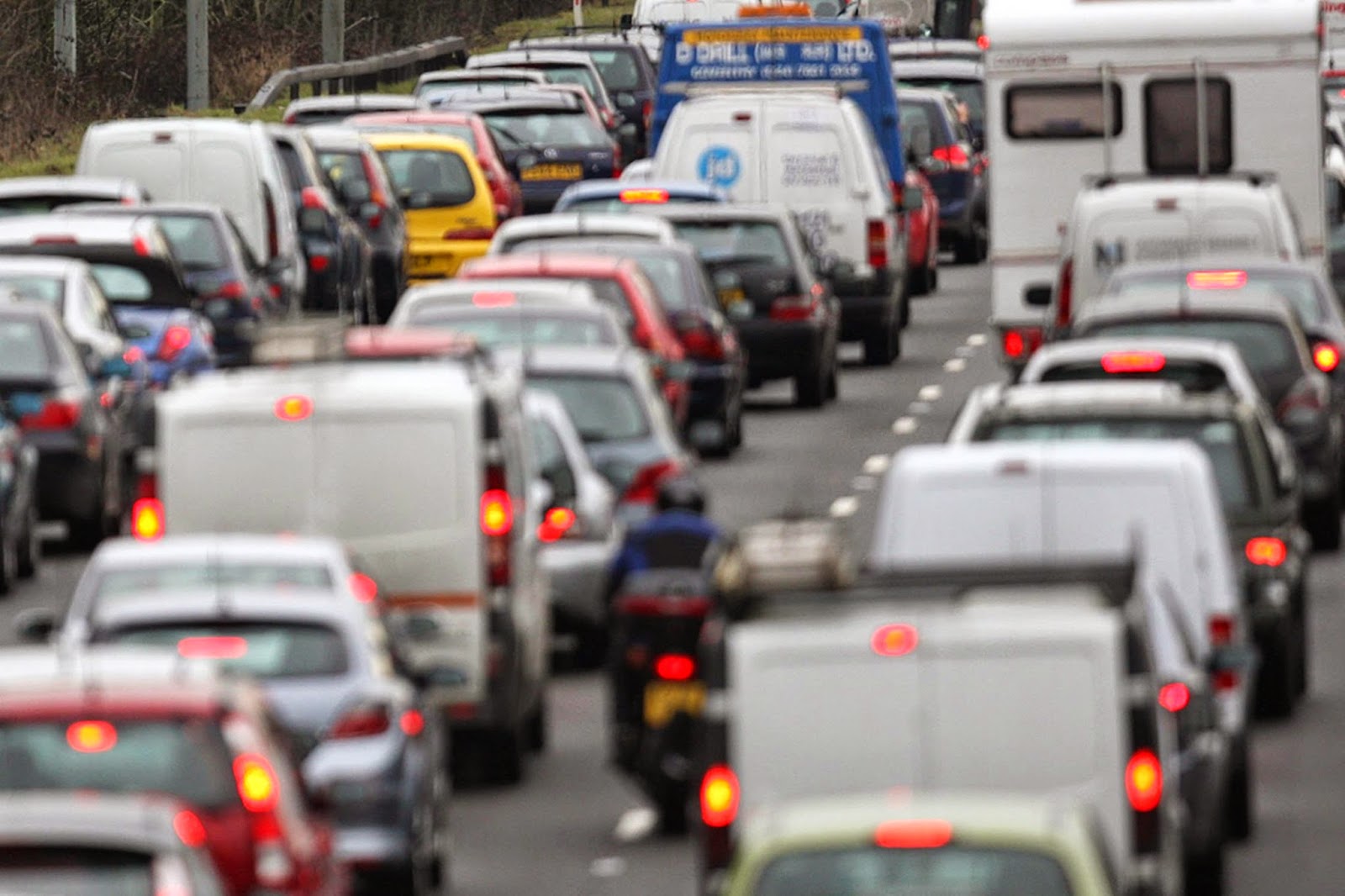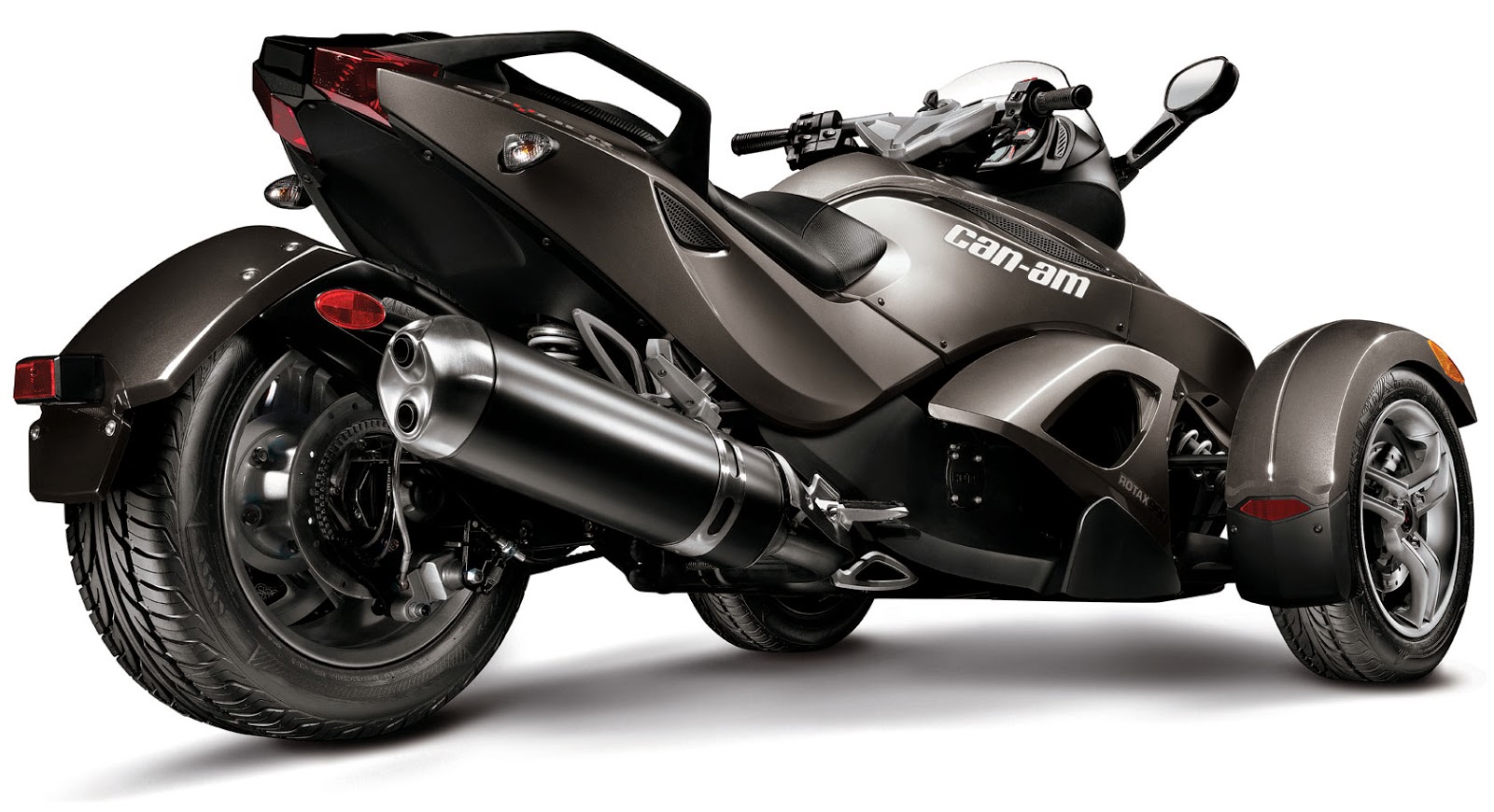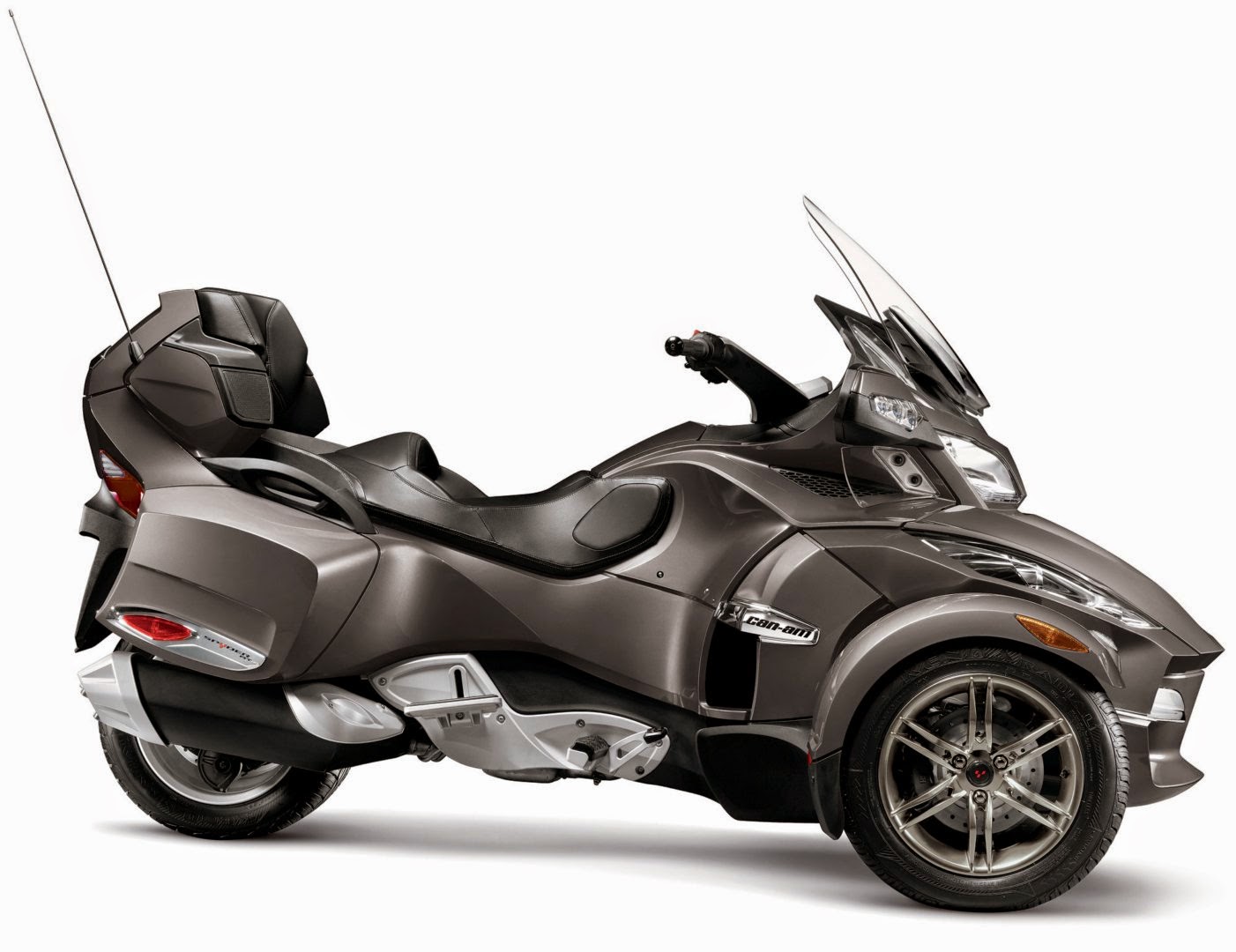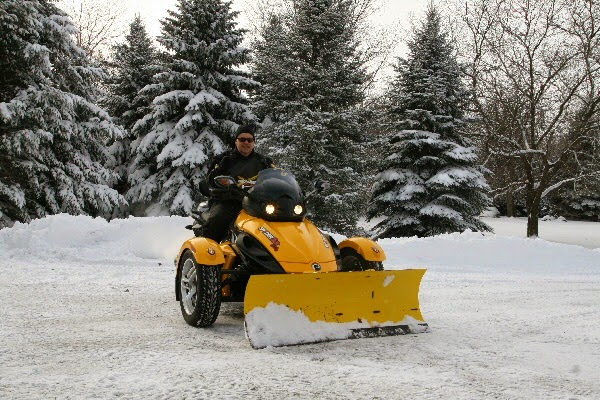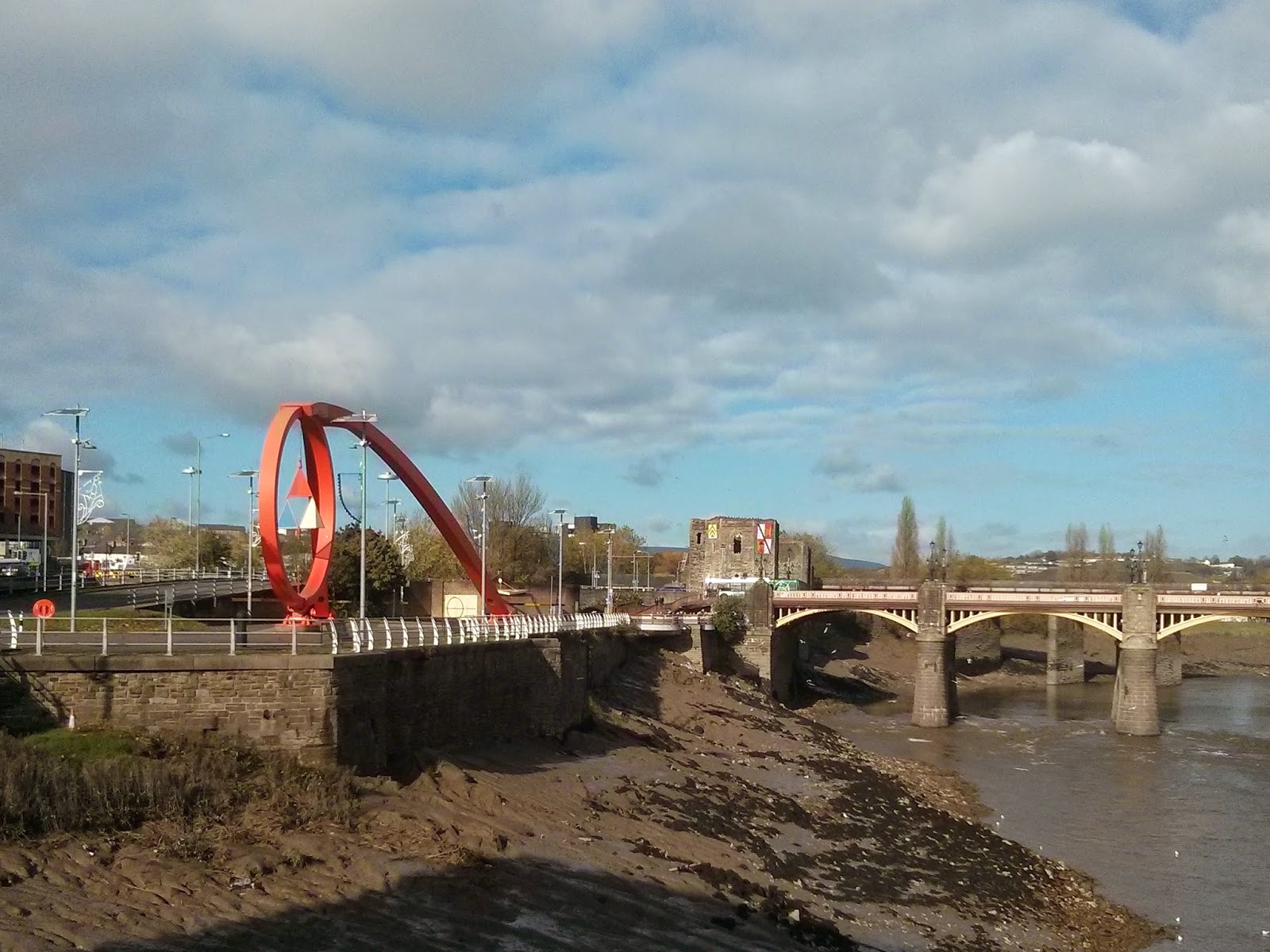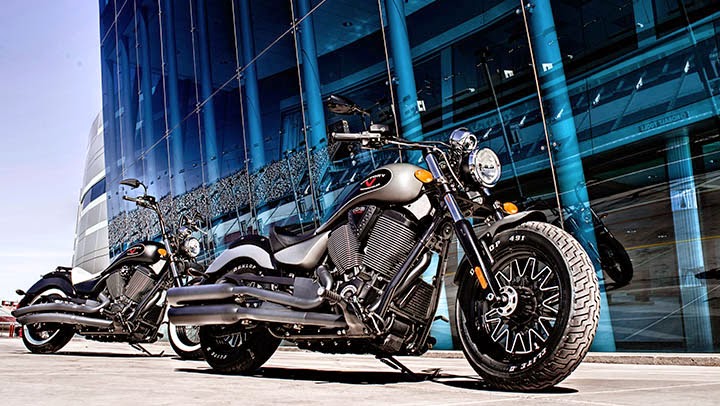I went to my first motorcycle show recently:
Motorcycle Live. The show takes place in Birmingham every year and is reportedly the country's largest.
I can believe that claim. The show runs for nine days, thereby incorporating two weekends, and when I was there on a Wednesday it was packed. Test rides booked up within minutes, empty places to sit were few and far between, and you had to do some pretty aggressive hovering to be able to sit on the models that appealed to you.
The models of motorcycles, that is. As opposed to the other type of model. I'm not sure we would have been allowed to sit on the underfed girls who prowled the convention halls shoving leaflets into people's hands.
I can't find any recent figures, but in 2011 the show drew more than 112,000. If you consider that the European economy has improved (just a tiny bit) since then, and there have been a huge number of new and interesting bikes announced this year, it's safe to say they are on track to do better this year. I'm terrible at gauging such things, but I'm willing to bet I was one of at least 10,000 people on the day I visited.
There was plenty of space for us, to be fair, with the hundreds of exhibitors and manufacturers spread through a number of gigantic aeroplane-hangar-sized halls. I suppose the cost of heating such an enormous space is where the bulk of one's £17 ticket price goes. And to that end, I don't imagine I'll go to Motorcycle Live again in the future. I loved getting a chance to see and sit on so many bikes, but overall I don't think it was worth the money, nor the effort I had to put into getting there. Birmingham is 125 miles from Cardiff; riding there in a cold drizzle was a whole lot of not-fun. Riding home in the same conditions was even worse in the dark.
Still, there were a number of positives and I came away from the show with lots of things for my motorcycle-loving brain to spin around on for the next several months. Here are my impressions of the show, organised by the manufacturers that drew my attention most.
BMW
![]() |
| Tiny men love this bike. |
Short guys fucking love the R1200GS. I don't understand this at all, considering it is such a tall bike, but they were swarming around this machine, almost crawling on top of each other for the opportunity to sit on it, squeeze the levers and click the gears up and down.
This is what you do at a motorcycle show, it would appear: click those gears as if they were your path to the Heavenly Kingdom. Make sure you put on a very serious face when you do it, too. You are testing the... uhm... something. It is serious business that demands a serious face. Equally, you should bend down and stare intently at a random part of the engine. Poke it and furrow your brow, so people know you are seriously assessing this bike seriously.
BMW fans were easily the most guilty of this behaviour. They were primarily also white males over the age of 40, with expensive shoes and hairstyles that would have been stylish 10 years ago. Being amongst them made me feel a little sad. I don't want to be one of these guys. But I sure as hell would love to own a BMW.
I have already stated my desire to own a
BMW F800GT. Finally getting to sit on one at the show only increased that desire. I also found myself intrigued by the F800R, which costs less than its fully-faired sibling and isn't as ugly as it looks in pictures. I was surprised to find myself generally unimpressed by the RnineT, but I really dug the R1200RS and R1200R models. I did not dig their prices. The R1200RS will start at £12,500 in Her Majesty's United Kingdom.
Meanwhile, the staff at the BMW area knew very little about BMWs. This was a common theme for all the exhibiting manufacturers. The F800GT on display was kitted with panniers and other extra bits, so I found a woman and asked her if she knew how much that bike would cost.
"There's the... uhm... on the... uh..." she said, pointing to a display board next to the bike.
"Yes," I said. "The standard price is there, but this bike has panniers, a top box, and some other stuff."
"If you... uhm.. ah..."
"You don't know, do you?"
"No. Sorry."
She directed me to a bloke who also didn't know.
Ducati
I couldn't care less about a Panigale; my attention went instead to the new
Scrambler, which looks pretty damn good in person. Though, I'll admit that something –– I don't know what –– cooled me on the bike a little. Maybe I'm just not that big a fan of scramblers. Maybe it's the fact that I really can't imagine quite how a Scrambler would fit to my actual life.
I liked it. I just didn't find myself sitting on it and thinking: "Oooh, I
need this."
EBR
The same could be said of the EBR 1190RX and 1190SX. Poor EBR got very little love from show attendees. People walked by without even glancing at these American-made machines. They were so ignored I felt I probably could have wheeled one out of the hall without being noticed.
That made me feel just a little sad, because I'm an American and I want to see American things do well. But I have to say I don't really blame all the people who ignored the EBR bikes. In person, they are not terribly exciting. The ergonomics of the bikes are awful for someone of my height and the seats are about as comfortable as laying a sweatshirt across a keyboard.
Harley-Davidson
![]() |
| Impractical but sexy –– Harley-Davidson Seventy-Two |
I don't really know what Harley's doing in terms of marketing in the United States these days, but over here they've gone for a completely different vibe than the one I had always known. This is a good thing, in my opinion. Remember that
all the old dudes on Road Kings I used to see when growing up in Minnesota are what put me off biking for so many years.
I saw none of that at Harley's area of Motorcycle Live. There were no leather vests with patches. No bandannas and long beards. No biker babes. None of the clichés. Instead, the exhibit area had a live DJ mixing house music replete with bleeps and bloops added via Launchpad. None of the stuff contained in that last sentence ("house music,""Launchpad") would make a damned bit of sense to the Sturgis crowd, and I love that fact.
Not too long ago, I had a conversation with the former head of marketing for Mercedes, who told me that one of the most important things to do when promoting a brand is to reduce your philosophy to three words –– four at the most. From there, you make sure that everything you do fits that three-word definition. Here, the three words I would have used for Harley-Davidson were: Unique, Intelligent, and Modern. If allowed to add a fourth, I would say Urban. I like seeing Harley-Davidson perform this tack.
I sat on a number of bikes and found them to be ergonomically awkward compared to those offered by other manufacturers. This is the same thing I experienced back when I got a chance to test ride the
Sportster 1200 and the
883 SuperLow. Harleys just don't seem to fit me well. The exception is the Seventy-Two, which I got to sit on and really enjoyed. I can't imagine how I could ever argue such a bike from a practical side, but man it was cool. Somebody buy me one, please.
Herald
Ever heard of
Herald Motor Company? Neither had I. They seem to be a Chinese outfit, offering a load of 125cc machines. But they are pretty cool-looking 125s. Odds of my ever owning one are extremely low. They drew my interest simply because I have a long-running fantasy of duping Jenn into riding by showing up one day with a 125 for her to learn on. She prefers
"real" motorcycles, so the aesthetics of these machines would suit her.
Honda
![]() |
Probably not the demographic Honda was
hoping to capture with the Vultus. |
Take the number of short dudes clamouring for a glimpse of the BMW R1200GS and increase it by a zillion: therein you have the number of bald and semi-bald white dudes in their 60s and beyond who were swarming the bulk of Honda's offerings. This made me a little sad considering I am a Honda owner, a general fan of Hondas, and a white guy. I don't want to be anyone's grandfather yet. But here I was hanging out with loads of them and finding much in common.
The redeeming aspect of this is that when you look at Honda owners in general they are a grubby crew who ride their bikes into the ground. Their gear is worn to hell from use. And I suppose, ultimately, that's the group you'd want to be associated with, even if they don't look as flashy as the BMW guys.
Meanwhile, as far as the actual bikes were concerned, I didn't really find myself swooning over them. Many models (e.g., the ST1300 Pan-European and the VT750 Shadow) are long in the tooth and in need of a refresh. Whereas others (e.g. NC750X, et al.) were so mind-numbingly practical I felt I needed a nap.
Also, the
Vultus looks terribly cheap in person, and its ergonomics were awkward. It's definitely off my list.
Some positives, however: Honda's sport bikes were drawing a decent amount of attention from younger white males, many of whom still had their hair or, at least, the wisdom to cover things up with a baseball cap. The look of CTX1300 continues to grow on me, though I still struggle to imagine scenarios in which I would choose to buy it over the similarly priced
Victory Cross Country. And I found the
CB500 series of bike (CB500F, CB500X, CBR500R) to be more formidably sized than I had previously realised. I could definitely picture myself getting by on a nicely-kitted CB500X –– still perfectly able to travel anywhere in the United Kingdom.
The new True Adventure bike
revealed at EICMA was on display, and I found one aspect of that bike to be particularly interesting: there was no clutch lever or gear pedal. That suggests Honda will be equipping the machine with the DCT automatic transmission, and creates a whole lot of questions.
Honda seems to be going all-in with its 750cc DCT platform, using it to create the NC750S, NC750X, NC750 Integra, Vultus, and probably soon in the bike currently known as the CTX700 (not sold in the UK) once Honda runs out of old 700cc stock. And now, apparently, the True Adventure. So, what does that mean for the NC750X? Does it get scrapped? Does Honda rework the X's engine to get a little more oomph and transform it into a
middleweight adventure-tourer? Will the True Adventure be an expensive novelty machine like the Vultus?
IndianI got a chance to test ride an Indian Chief Classic as a part of the show and will be writing up a review in the near future. The short review is that it is an amazing machine.
What I was most looking forward to seeing, however, was the new
Indian Scout. It is a beautiful machine up close and I am delighted to report that its ergonomics were perfectly agreeable to my 6-foot-1 frame.
I am looking forward to test riding the bike once it officially arrives in Blighty in March. The day the Scout was launched back in August I called my nearest Indian dealership,
Blade Victory and Indian in Swindon, and asked to be contacted as soon as test rides are available.
Swindon is some 80 miles from Penarth, which would be a pain in the ass if I were a Victory or Indian owner and needed work done. Though, the guys at the Indian area of the show said the company is working on expanding its dealer network.
In contrast to the image of urban modernity being promulgated Harley-Davidson, the three words I would use for Indian's approach are: Authenticity, Heritage, and Quality. Again, though, there were no leather vests with patches, no biker girls, no incessant blaring of "Born to Be Wild." The feeling was high-end, and I think it "sold" well to the crowd. In a country where cruisers get the least amount of love, Indian was garnering quite a lot of wide-eyed attention. I found it especially refreshing to note how many women were keen to sit on these bikes.
Indeed, throughout the show I noticed that women gave most of their attention to cruisers and classic-styled machines –– the "real" motorcycles my wife likes. I would hope that some of the manufacturers' marketing teams were there to notice this. With the exception of Harley-Davidson, too many manufacturers are ignoring women as customers.
Kawasaki![]() |
| Kawasaki Vulcan S |
Women were giving a lot of love to the new Kawasaki Vulcan S, too. Though, they weren't the only ones. Indeed, with the possible exception of the
Triumph Bonneville range, I saw no other bike at the show drawing so much attention from such a wide range of ages, genders and social classes. Kawasaki had three models of the
Vulcan S on display and still you had to muscle your way through the crowd to sit on one.
Previously I described the Vulcan S as looking a little "meh" to my tastes, but I rescind that criticism having now had a chance to see it in person. It has a great, quality look, is nice and roomy, and is comfortable as all get out to sit on. I have promised myself that I will test ride one as soon as I can. This is dangerous, because the Vulcan S is "affordable" (less than £6,000) and a positive test ride might result in my just going nuts and getting one.
Royal-EnfieldThe Continental GT; what a joke. Uncomfortable to sit on, tiny, and looks cheaply made. I was thoroughly underwhelmed. As were most show attendees, it seems –– the Royal-Enfield area was almost as quiet as the EBR space. Whereas it makes sense for a small, relatively new American company to get little attention it felt a little sad to see a long-standing brand like Royal-Enfield being so ignored.
The bikes getting the most attention were the
Classic 500s. They were quite popular with ladies who appeared to be in their 70s and 80s. Seeing this, it suddenly became clear why Royal-Enfield has struggled in recent years to find a UK distributor.
SuzukiWhereas some of Honda's models are long in the tooth almost
all of Suzuki's are. And even those that aren't look that way. Case in point: the "new" GSX-S1000F. Its awful paint scheme makes it look 10 years old. Playing the three-word marketing game with Suzuki, the words that come to my mind are: Affordable, Decent, and... uhm... Affordable. Suzuki's bikes are just a little underwhelming.
Regardless, I am still
saving up to get a GSX1250FA. To that end, I spent a lot of time staring at and sitting on the GSX1250FA that was on display at the show. I am pleased to report that I found the ergonomics to be quite agreeable.
Additionally, I found myself warming to the V-Strom 650. It is a formidably sized machine and for all the European journeys that I imagine myself taking on a GSX1250FA, I suspect the V-Strom would be just as well suited if not in some cases better. And it gets better mpg. This is something
Bob Leong told me years ago; I trust he's in heaven now saying "I told you so."
Triumph![]() |
You have to pay extra for a fuel cap that locks.
Because Triumph. |
The staff at the Triumph area knew very little about Triumphs. They did not know when the Bonneville line will get ABS. They did not know if the alloy-wheeled Bonneville can take radial tires. They did not know whether certain Bonneville accessories would fit the Speedmaster. They did not know if you can simply add cruise control to the Tiger XR or if you inherently have to get a Tiger XRx. And on. It was annoying.
That didn't stop me from falling in love with the Thruxton, though. My local dealership doesn't have one on display, so I'd not really had a chance to stare at one in person before. Yes, it uses stupid bias tires and the mirrors are only a tiny step above useless and I wouldn't even consider buying one until Triumph adds ABS and you have to pay extra to get a fuel cap that locks, but it is so
cool! I mean, really, really cool. Especially in green.
That bike is so cool some part of my brain has already started to rationalise getting one. My ultra-practical side, the side that is trying to keep me from locking myself into the challenge of making monthly payments, is clinging to my ABS dogma like a priest clutching a crucifix at an exorcism. When Triumph eventually delivers anti-lock brakes (I would expect to see it announced before the summer), I may not be able to hold out any longer. Practicality be damned.
VictorySpeaking of bikes that look good in green, oh my goodness is the
Gunner a sexy beast. I have never seen a picture of this bike that manages to capture just how attractive it is in real life. Sitting on the machine, I felt a deep urge to just hug it and thereafter refuse to let go. I could easily imagine a scenario in which staff from the National Exhibition Centre were having to pry me off the bike as I wept and shouted: "It's mah baby! She needs me!"
The seat of the Gunner is ridiculously comfortable; the overall ergonomics of the bike felt ideal. Whether the Gunner is £1,300 better than the £9,000 Victory Vegas 8-Ball, however, is up for debate. I realise the former is presently the only Victory cruiser with ABS as an option, but oof.
Meanwhile, I continue to be disappointed by Victory's marketing strategy. Here is where you hear classic rock being blared. Here is where you see scantily clad women tottering on high heels who don't know a goddamn thing about the bikes they're shilling. I mean Not. A. Single. Fucking. Thing.
At one point in the afternoon, there was a guy who demonstrated that Victory bikes can actually be manoeuvred into very tight turns (if you've had shedloads of training and you don't mind the very high possibility that you'll drop your bike). As he was setting up, one of his crew was flirting with a Victory girl and showing her
how to start the bike. He had to show her how to twist the throttle.
I almost started screaming. That kind of bullshit is everything that's wrong with motorcycling. All those females at the show who were paying attention to cruisers and classic-styled machines, you will never sell to them if the underlying message of your marketing is that women exist solely to be stared at.
Don't get me wrong, I like sexy women; I married one. But I can just imagine what my wife's response would be if I were to take her to a Victory event where Lycra-clad anorexics galumph about on 6-inch heels amid a soundtrack by The Offspring. In the game of trying to convince her that bikes are a really good idea we should spend money on, I'd be set back a decade.
Motorcyclists often scoff at this idea –– and there are always exceptions –– but when you buy a bike you are buying into a lifestyle. Or, at the very least, you are buying into an acceptance of a lifestyle, a willingness to be associated with that lifestyle. Buy a Honda and you are embracing all those raggedy old white men. Buy a BMW and you are welcoming the association with short, rich guys. Buy a Suzuki and you're telling the world you're a cheapskate. Buy a Triumph Bonneville and you're showing love for those who take facial grooming very seriously. I'd accept those other associations. I do not want to be a part of or condone the idiot misogyny implied by Victory's marketing.
I weep for Jaqui van Ham.
WK Bikes![]() |
| WK 650TR (aka CF Moto 650TR) |
For quite some time I have pondered whether the WK 650TR –– aka the CF Moto 650TR –– is a bike worth having. A China-made machine whose engine copies the Kawasaki Ninja 650 (aka ER-6 outside the United States) and wears the aesthetics of a Honda ST1300, its price is incredibly appealing. In the UK, it will set you back just £5,200
For that, you get a fully faired bike capable of nigh 68 hp that has incorporated hard panniers, a fancy little 12V plug for your sat-nav/phone, and some nifty wee storage compartments in the fairing. By comparison, if you were to get an actual Ninja 650R (known as an ER-6f in the UK) and add accessory panniers and 12V plug, you'd likely be paying close to £7,200.
Of course, you'd also be getting a Kawasaki. With the WK, you get a bike whose name changes depending on which country its sold in and a sparse dealer network made up of independent shops that look as if they are about to shut down. In fact, they frequently do –– a number of dealers listed on WK's site no longer exist.
But still. What if? That's what any economy-minded motorcyclist asks. What if this WK 650TR were actually good enough? What if I really could get all that bike, brand new, for so little money?
I know other people ask this, too, because the two 650TR machines on display were drawing a decent amount of attention at Motorcycle Live. And clearly all of the people looking had similar concerns about quality. Every bloke I saw get near the bike would first take a furtive glance to make sure no staff were watching, then strike some part of the bike with a certain amount of force. They were yanking on the panniers, banging the tank with their wedding rings, tugging at the doors of the fairing compartments, thunking the mirrors, mashing the pedals, squeezing the levers and otherwise treating the display models as roughly as they felt they could get away with. And when I say "they" I mean "we."
If you consider that thousands of people were doing this day after day, it seems the build quality of the 650 TR is pretty good. What that says for the actual running of the bike, I'm not sure. The truth is, I still don't think I'd trust it. Not least because the 650TR does not come with ABS. A quick glance at AutoTrader tells me that a 2010 ER-6f with antilock brakes and less than 5,000 miles on the odometer can be had for £3,100. Givi panniers and a 12V plug will add another £500 or so. That leaves you paying £1,600 less than the asking price of the 650TR, with a still-higher resale value and a legitimate dealer network.
Oh, and I forgot to mention that the 650TR's 12V plug is oddly located right where my knee pushes against the fairing, which means it would probably be useless. My leg would be accidentally disconnecting whatever I had plugged in. I realise I am a bit tall for the bike but I can't imagine anyone being so tiny they would not disrupt the plug. Except for a baby. And babies really should not be riding full-size motorcycles; it's dangerous.
Yamaha![]() |
| Yamaha MT-09 Tracer (aka FJ-09) |
Instead of getting a 650TR you could get an
MT-07. Because that is one of the best bikes I've ever ridden. Equipped with ABS it costs just £100 more than the Chinese bike. No, it doesn't have any wind protection or panniers but it is so much fun you won't care.
The bike of most interest to me at the Yamaha exhibit, however, was the newly announced
MT-09 Tracer (aka the FJ-09 in the United States). It's got the look of a legitimately solid and useable machine, comfortable ergonomics and will be priced at £8,100 in the UK. That puts it at almost £2,000 less than most of its competition and still several hundred pounds cheaper than the new Triumph Tiger XR, while offering more standard amenities.
Though, you know, if you do a side-by-side comparison, the difference in price is somewhat visible. Just by looking, a person could probably guess the cheaper bike. That's OK, because the MT-09 Tracer is still (probably –– I haven't test ridden one yet, obviously) a good bike. But it's something to be aware of.
What's baffling is that you would have the same experience when comparing the
XV950 (aka Star Bolt) and the Harley-Davidson Iron 883. But in this case you'd be wrong about the cheaper bike. The Yamaha actually costs more in the UK. I personally think the Yamaha is overall the better bike, but it is not so much better as to be worth more than a Harley. This is especially true when you can do such direct comparisons in build quality.
I was able to look at the H-D Iron, then walk across the hall and look at the XV950 and see that the latter really doesn't match up. It doesn't even match up against the Kawasaki Vulcan S, which costs almost £2,000 less (the ABS-equipped Vulcan S costs £5,950; the Harley-Davidson Iron 883 with ABS costs £7,650; the XV950R [ABS equipped] costs £7,800). That's a damn shame because I really, really like the XV950. You'd be silly to pay so much more for it, though.
Other stuff
- Did you know Peugeot makes scooters? I didn't either. That's probably down to the fact that I pay almost no attention to scooters. If I lived in London or an equally sprawling mega-city, I'd probably be crazy for them. They certainly look like fun and I dig how much stuff they hold.
- I saw three black people at the show. Three. This was in Birmingham, which is one of the most ethnically diverse cities in Britain and home to the largest black population outside of the London metropolitan region. Three black people, y'all. Whereas there is still work to be done in attracting women to motorcycling there is a whole lot of work to be done in attracting minorities.
- £10 for a cheeseburger, fries and a soda.
- The NEC offered free, covered, secure motorcycle parking. Through this, one of the highlights of the show for me was the opportunity to chat with different people about the bikes they rode. I got into a particularly long conversation with an old white dude from East Anglia about his 11-year-old Honda ST13000 Pan-European, upon which he had ridden some 87,000 miles thus far. Apart from brake pads, tires and the like, he had experienced no problems with the machine and lamented the fact he had no reason to get rid of it. I decided he was a pretty cool dude and secretly admitted to myself that if the opportunity ever presents itself, I will definitely get an ST1300. Though, if I do, I will in my mind probably associate myself with Steve Johnson, who is neither old nor white.






